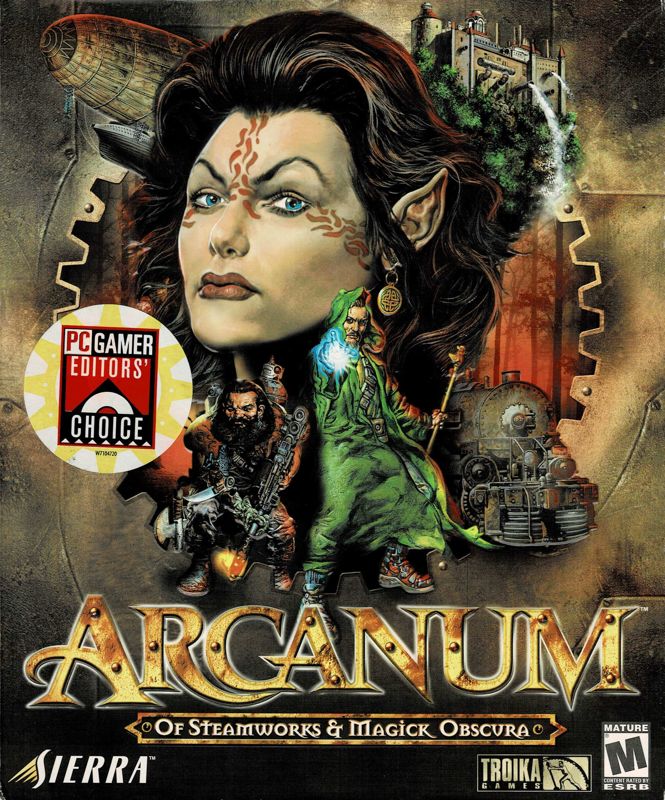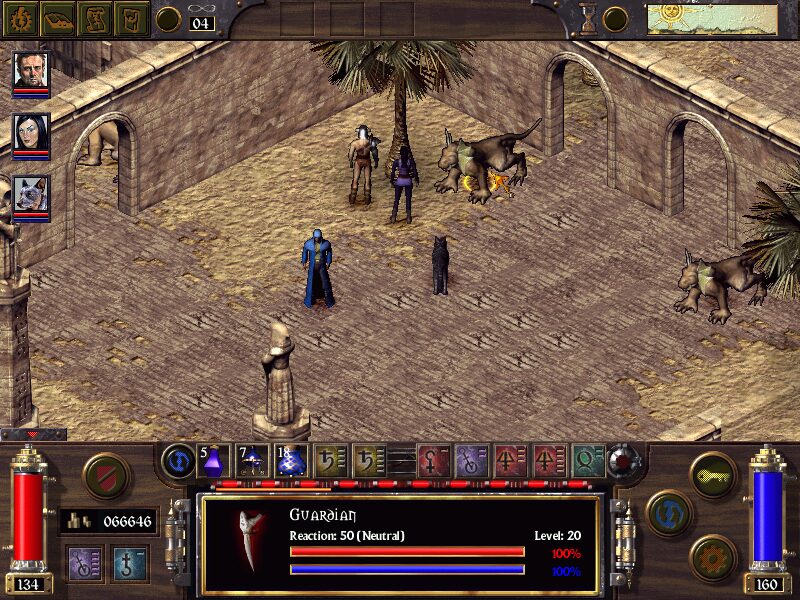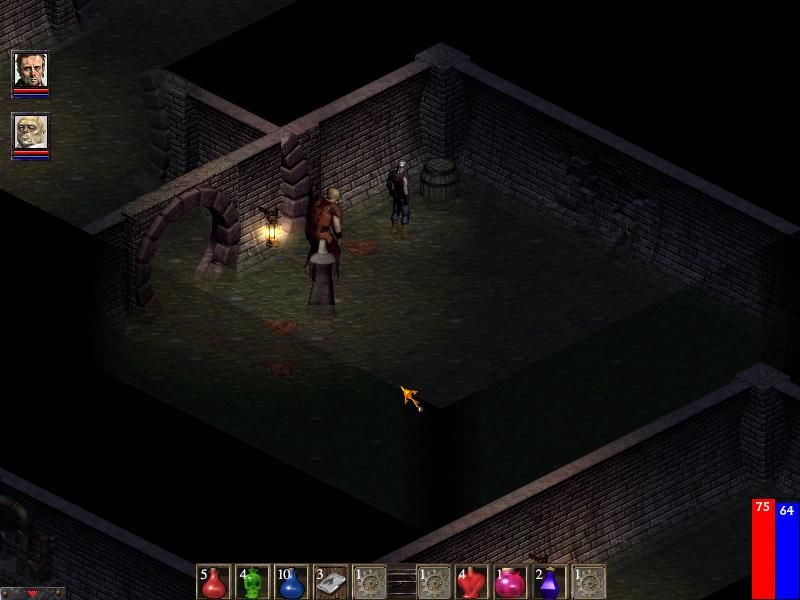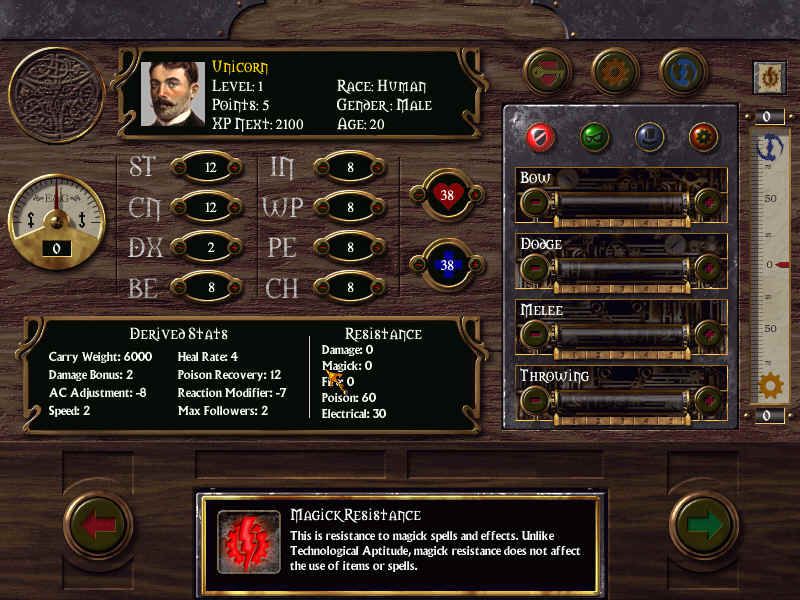Retro Replay Review
Gameplay
Arcanum: Of Steamworks & Magick Obscura delivers a robust role-playing experience that balances freedom of choice with deep mechanical systems. From character creation onward, you decide whether to walk the path of technology, magic, or some hybrid in between. You choose your race—human, elf, dwarf, half-orc, halfling, or an uncommon gnome—each offering unique starting bonuses, social reactions, and racial abilities. Attributes and skills are entirely player-defined, and every level-up grants points you can allocate to mortal prowess, spellcasting talents, or technical proficiencies.
(HEY YOU!! We hope you enjoy! We try not to run ads. So basically, this is a very expensive hobby running this site. Please consider joining us for updates, forums, and more. Network w/ us to make some cash or friends while retro gaming, and you can win some free retro games for posting. Okay, carry on 👍)
Combat in Arcanum is equally flexible. Three modes are on offer: fully real-time, turn-based, and a “fast-paced” variant of turn-based. Real-time delivers a classic isometric hack-and-slash feel, while turn-based channels the tactical pacing of Fallout’s action-point system. The fast-paced turn-based strikes a middle ground, giving you quick decisions without frantic button-mashing. No matter your preference, the game rewards thoughtful positioning, skill synergy, and judicious use of potions or gadgets.
What truly sets the gameplay apart is its emphasis on role-playing beyond combat. Social interaction is a core pillar: persuasion, etiquette, and streetwise negotiations can open doors that swords or spells cannot. Your charisma and intelligence attributes, combined with trained social skills, allow you to defuse conflicts, secure information, or even recruit new companions. NPCs react dynamically to your choices—ally with a half-giant mercenary, insult a city guard, or backstab a smuggler lord, and you’ll see reputations shift in real time.
Graphics
Arcanum’s visual style is a distinctive meld of hand-painted 2D backgrounds and richly detailed sprites. The world feels alive with its steampunk-tinged architecture, from smog-choked factories to opulent Victorian manors. You can admire the artful contrast between the stern lines of iron-forged machinery and the flowing runes carved into ancient magical relics.
The isometric perspective offers a broad, strategic view of environments. Forests are rendered with vibrant foliage, each tree showing subtle animation when the wind blows. Dwarven forges glow warmly in subterranean caverns, while slate streets of metropolitan districts glisten under lamplight. Day-night cycles and weather effects, although simple by modern standards, contribute to the atmosphere and even influence monster behavior during your travels.
Character sprites and monsters boast impressive detail for a late-’90s RPG. Every race—elf, half-orc, gnome—has a unique silhouette and armor style that conveys their cultural background. Magic spells exhibit colorful particle effects, while technological gadgets spark and whirr with believable mechanical sounds. Though dated by today’s high-definition norms, Arcanum’s art still captivates with its creativity and cohesive aesthetic.
Story
The narrative of Arcanum begins with a dramatic zeppelin crash that sets the tone for a world on the brink of transformation. As the luxury craft IFS Zephyr plummets over the Kingdom of Arland, two half-ogres die in a fiery descent, leaving only two survivors—a young man bearing a mysterious silver ring and an old gnome gravely wounded. With his last breath, the gnome implores the ring-bearer to “find the boy,” igniting a journey of mythic proportions.
Shortly after the crash, a witness named Virgil identifies the protagonist as “The Living One,” hinting at an ancient prophecy and the rebirth of a dormant deity. This revelation propels you on a quest to uncover your true origins, the significance of the silver ring, and the shadowy forces behind the attack. Along the way, you traverse sprawling cities, remote villages, and treacherous wilderness, each locale offering new clues, factions, and moral quandaries.
Arcanum’s world is torn between magical tradition and technological progress. Elven clans cling to arcane arts, viewing steam-powered inventions as blasphemous, while humans and dwarves champion industrialization. This central conflict permeates the storyline and shapes every dialogue choice. Whether you broker peace between rival factions or fan the flames of war, your decisions carry weight, altering alliances and unlocking alternate endings in a richly branching narrative.
Overall Experience
Arcanum stands as a testament to ambitious world-building and player agency. Its blend of steampunk and high fantasy feels fresh, even decades after release. The game rewards diligent exploration: hidden dungeons, side quests, and subtle narrative threads abound, granting hundreds of hours of gameplay to those eager to dive into its secrets. Companions—ranging from a trigger-happy dwarf engineer to an aloof elf mage—bring life to your journey, each offering unique backstories and side missions.
The learning curve can be steep, especially for newcomers to classic RPGs. Inventory management, skill synergies, and puzzle-like dialogue encounters may overwhelm at first. Yet this complexity is also part of Arcanum’s charm. Mastering the interplay of firestorms and rifles, or steam-powered automatons and healing spells, fosters a genuine sense of accomplishment.
For players who relish open-ended RPGs with richly woven lore, Arcanum is a must-experience. Its WorldEdit tool even lets fans create custom scenarios, extending the game’s longevity through user-made campaigns. Whether you’re drawn by the epic storyline, inventive setting, or depth of choice, Arcanum offers a singular journey that resonates long after the credits roll.
 Retro Replay Retro Replay gaming reviews, news, emulation, geek stuff and more!
Retro Replay Retro Replay gaming reviews, news, emulation, geek stuff and more!









Reviews
There are no reviews yet.